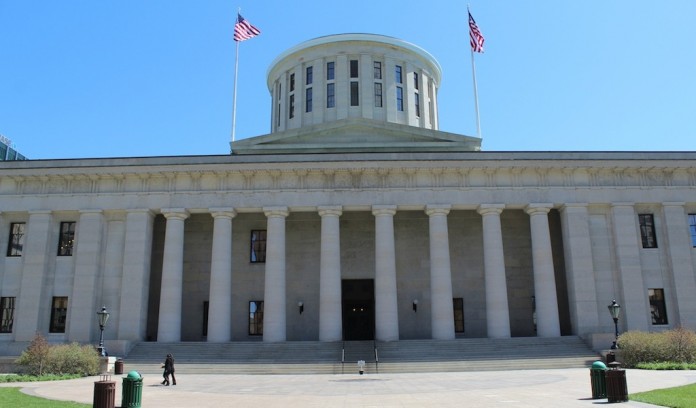COLUMBUS — Ohio farmers and farm groups are continuing to push for reform in the way their farm property taxes are calculated.
During a state Senate Ways and Means Committee hearing Feb. 22, at the Statehouse, proponent testimony was heard on S.B. 36 — a bill that would remove certain non-agricultural factors from the state’s Current Agricultural Use Value formula, and limit the taxable value of land devoted to conservation.
Same goals
The bill generally mirrors legislation that was heard in the Senate committee last year, but died without a vote.
Jenna Beadle, director of state policy for the Ohio Farm Bureau Federation, said Ohio farmers saw a 307 percent increase in property taxes between 2008 and 2014.
She said farm income did increase significantly from about 2010-2012, with a 100 percent increase in commodity prices. But during the same time, taxes increased about 300 percent, or three times more than commodity prices.
The problem lies with the CAUV formula, according to Farm Bureau and the Ohio Farmers Union. The current formula uses equity buildup and appreciation of farmland, and has also been impacted by historically low interest rates, which cause a higher tax rate.
Proponents believe by eliminating what they consider “non agricultural factors,” the formula will better reflect true agricultural value.
Accurate formula
Beadle said even with the changes being proposed, CAUV taxes will continue to increase, but not as dramatically.
“We’re looking for accuracy in this formula and not a complete overhaul,” she said.
Mike Bensman, Farm Bureau trustee from Shelby County, farms about 4,000 acres with his family. He said the spike in taxes has hurt the industry.
“For those of you who have worked in small business, ask yourselves if you would be able to manage a tax increase of 300 percent,” he said.
Katherine Harrison, a Farm Bureau trustee from Canal Winchester and a livestock producer, told the committee about the difficulty in purchasing farmland today.
She recently bought 44 acres of her family farm and expects to rent the land for about $180 an acre, with taxes that will cost her $120 an acre. That would leave her with $60 per acre, per year, to pay the purchase loan of $300,000.
Sen. John Eklund, R-Geauga County, who chairs the Senate Ways and Means Committee, said the concept of S.B. 36 seems reasonable.
“The concept behind it is widely supported, which is to say, do something with the formula that helps to even out the crazy swings that we’ve seen over the course of the last few years,” he said. “The question will become whether the proposal in the bill is best way to do it or not.”
He expects hearings will continue over the next few weeks, with more opportunity for proponents, as well as interested parties and opponents. He also anticipates testimony from the governor’s administration, and might also seek testimony from independent tax experts.
“The idea is to get as much information as we can,” he said.
Other views
Opponents last year included some county auditors and school districts, who feared the changes would cause a loss of funding and a tax shift onto residential property owners.
The Buckeye Association of School Administrators and the Ohio Association of School Business Officials both testified in November, about the tax shift.
In its analysis of the current bill, the Ohio Legislative Services Commission concluded that the changes to CAUV could result in losses of revenue to school districts of up to $18 million or more, beginning in fiscal year 2018. The loss of revenue to local government could be up to $19 million or more.
Farm groups contend that not fixing CAUV will also be costly to schools — because the owners of CAUV ground will be less likely to support future levies.
“We’ve had a situation where a lot of our members are really struggling with levies in their districts and rural districts are not able to (pass) their levies,” Beadle said. “We perceive that if the tax burden was more manageable, that the rural districts would be able to support more levies.”
Hurting levies
Ted Finnarn, a Darke County attorney who represents Ohio Farmers Union, and serves on the state’s ag advisory committee for taxation, said farmers are already organizing against levies, because of what has happened.
“If you think schools are going to have less money, hell yes they’re going to have less money,” he said, because farmers will be less willing to vote for local taxes when facing high real estate taxes.
Finnarn also spoke critically of how farmers have been treated the past few years, and said when the governor and legislature talk about lowering income taxes, they should keep in mind the increases put on farmers.
He referred to one farmer who saved $50 from the income tax cuts, but paid $5,000 more in property taxes.
Related coverage:
- Ohio Legislature punts on CAUV tax reform (Dec. 2, 2016).
- CAUV bills on hold in House and Senate committees (May 23, 2016).
- Ohio House committee hears CAUV testimony (May 4, 2016).
- County auditors and farmers testify on CAUV bill (April 29, 2016)
- High real estate taxes pressuring woodland owners and farmers (April 26, 2016).
- First proponent hearing on the Senate CAUV bill (April 12, 2016).
- Ohio lawmakers seek additional CAUV changes (November, 2015).
- Landowners sue Ohio over CAUV calculation (June, 2015).










